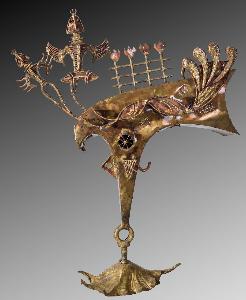Shankar Nandagopal
Shankar Nandagopal;S. Nandagopal
Mjesto: Bengaluru
Rođen: 1946
Smrt: 2017
Biografija:
Shankar Nandagopal was a renowned Indian sculptor and painter, known for his exceptional work in metal sculptures. Born in 1946, he was one of the last members of the Madras Art Movement, which played a significant role in pioneering modernism in art in South India. As the son of K. C. S. Paniker, the founder of the Cholamandal Artists' Village, Shankar Nandagopal's artistic journey was deeply influenced by his father's legacy.
Early Life and Career
Shankar Nandagopal's early life was marked by his exposure to art at a young age. His father, K. C. S. Paniker, was not only an artist but also the principal of the Madras School of Arts, making him a significant figure in the Indian art scene. This early exposure had a profound impact on Shankar Nandagopal's career, as he went on to become a two-time recipient of the Lalit Kala Akademi Award. Shankar Nandagopal was awarded the Jindal Stainless Steel Award for Sculpture in 2002, which further solidified his reputation as a skilled sculptor. His work in metal sculptures is characterized by its unique approach to depicting space and form, making him a notable figure in the Indian art scene.
Artistic Style
Shankar Nandagopal's artistic style was heavily influenced by the Madras Art Movement, which emphasized modernism and experimentation. His use of metal as a medium for sculpture was particularly noteworthy, as it allowed him to create intricate and complex pieces that showcased his skill and craftsmanship. Shankar Nandagopal's work can be seen as a continuation of the Indian Space painting art movement, which emerged during the Mughal era. This movement was characterized by its unique approach to depicting space, using a combination of traditional Indian and Persian influences. Shankar Nandagopal's use of metal sculptures can be seen as an extension of this movement, as it allowed him to create three-dimensional pieces that explored the relationship between form and space.
- Shankar Nandagopal's work was influenced by his father, K. C. S. Paniker, who was a pioneer of modernism in Indian art.
- He was awarded the Jindal Stainless Steel Award for Sculpture in 2002, which further solidified his reputation as a skilled sculptor.
- Shankar Nandagopal's use of metal sculptures allowed him to create intricate and complex pieces that showcased his skill and craftsmanship.
Legacy
Shankar Nandagopal's legacy can be seen in the numerous artists who have been inspired by his work. His contribution to the Indian art scene is undeniable, and his use of metal sculptures has paved the way for future generations of artists. The National Gallery of Modern Art in New Delhi, India, has a significant collection of modern and contemporary art, including works by Shankar Nandagopal. The Vera Bluemner Kouba Collection is a notable example of this, with its focus on American modernism and Precisionist art. Shankar Nandagopal's work can be seen as a testament to the enduring legacy of the Madras Art Movement, which continues to inspire artists today. His use of metal sculptures has left an indelible mark on the Indian art scene, making him a notable figure in the history of modern Indian art. Shankar Nandagopal's passing in 2017 marked the end of an era, but his legacy continues to inspire and influence artists around the world. His work remains a powerful testament to the enduring legacy of the Madras Art Movement and the significant role he played in shaping the Indian art scene.


